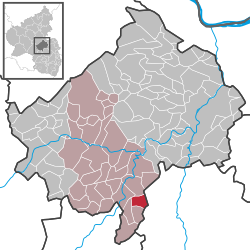Callbach
| Callbach | ||
|---|---|---|
|
||
| Coordinates: 49°42′13″N 7°41′57″E / 49.70361°N 7.69917°ECoordinates: 49°42′13″N 7°41′57″E / 49.70361°N 7.69917°E | ||
| Country | Germany | |
| State | Rhineland-Palatinate | |
| District | Bad Kreuznach | |
| Municipal assoc. | Meisenheim | |
| Government | ||
| • Mayor | Lothar Geib | |
| Area | ||
| • Total | 5.39 km2 (2.08 sq mi) | |
| Elevation | 223 m (732 ft) | |
| Population (2015-12-31) | ||
| • Total | 367 | |
| • Density | 68/km2 (180/sq mi) | |
| Time zone | CET/CEST (UTC+1/+2) | |
| Postal codes | 67829 | |
| Dialling codes | 06753 | |
| Vehicle registration | KH | |
Callbach is a municipality in the Bad Kreuznach district in Rhineland-Palatinate, Germany. It belongs to the Verbandsgemeinde of Meisenheim, whose seat is in the like-named town.
Callbach is a linear village (by some definitions, a “thorpe”) that lies in the North Palatine Uplands at the Eschelbach valley, a side dale of the Glan.
Clockwise from the north, Callbach’s neighbours are the municipalities of Rehborn, Unkenbach, Finkenbach-Gersweiler (both in the neighbouring Donnersbergkreis), Schmittweiler, Reiffelbach and the town of Meisenheim.
Also belonging to Callbach is the outlying homestead of Lindenhof.
After the Congress of Vienna, which about 1815 and the years that followed imposed a new political landscape on the region after Napoleonic French rule had ended, Callbach belonged to the Rheinkreis along with much of the Palatinate, a new exclave of the Kingdom of Bavaria. It remained Bavarian until the end of the Second World War, since which time it has been part of the then newly founded state of Rhineland-Palatinate. In the course of administrative restructuring in this state in 1969, Callbach was transferred from the former Rockenhausen district (which was at the same time dissolved) to the Bad Kreuznach district, in which it still finds itself now. From an ecclesiastical standpoint, Callbach has long belonged to the Evangelical Church of the Palatinate (Protestant) and to the Roman Catholic Diocese of Speyer.
...
Wikipedia



